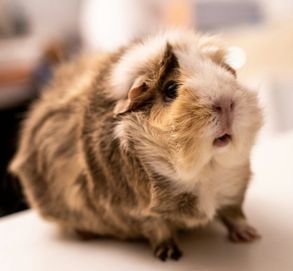
The term “dystocia” means trouble giving birth, which unfortunately isn’t an uncommon problem in guinea pigs. Due to the combination of rather large babies for their body size and the propensity for the pubic symphysis to fuse after the age of 7 months, it is fairly common for babies to become stuck during the birthing process.
A guinea pig’s pregnancy lasts approximately 28 days. The birthing process in guinea pigs is normally a very rapid process. Any guinea pig experiencing active contractions for more than 20 minutes without producing a baby or if a guinea pig has gone more than 2 hours between babies should be considered experiencing dystocia. This is a medical emergency for both the babies and the mother. If you think your guinea pig is struggling to give birth they should be seen immediately by a veterinarian.
Expectant mothers actively straining for more than 20 minutes or has been intermittently straining on/off for over 2 hours. This is more likely in first-time mothers 9 months or older as the pubic symphysis fuses at 7 months.
Conditions that may have similar appearing clinical signs include uterine torsion, bladder stones, uterine infection (pyometra), or uterine tumors.
Your veterinarian will recommend radiographs to evaluate the pubic symphysis, number of babies, their position, and size and an ultrasound to evaluate fetal viability to check for heartbeats.
The first step is to stabilize to save mom. This is accomplished with intravenous fluids and pain medications. Afterward, proceeding to surgery to remove and hopefully save the babies. Even if the babies are deceased, surgery will still be necessary to save the mother. Following surgery, your vet may recommend mom stay in the hospital until she has recovered and may be recommended antibiotics or nutritional support with assist feeding depending on her condition and the cause of the dystocia.
The prognosis is fair if surgery is performed and there are minimal to no complications.
Recheck with your veterinarian in 7-10 days to check the surgery incision. Additional rechecks may be recommended depending on how she is doing.
Copyright © All Rights Reserved
